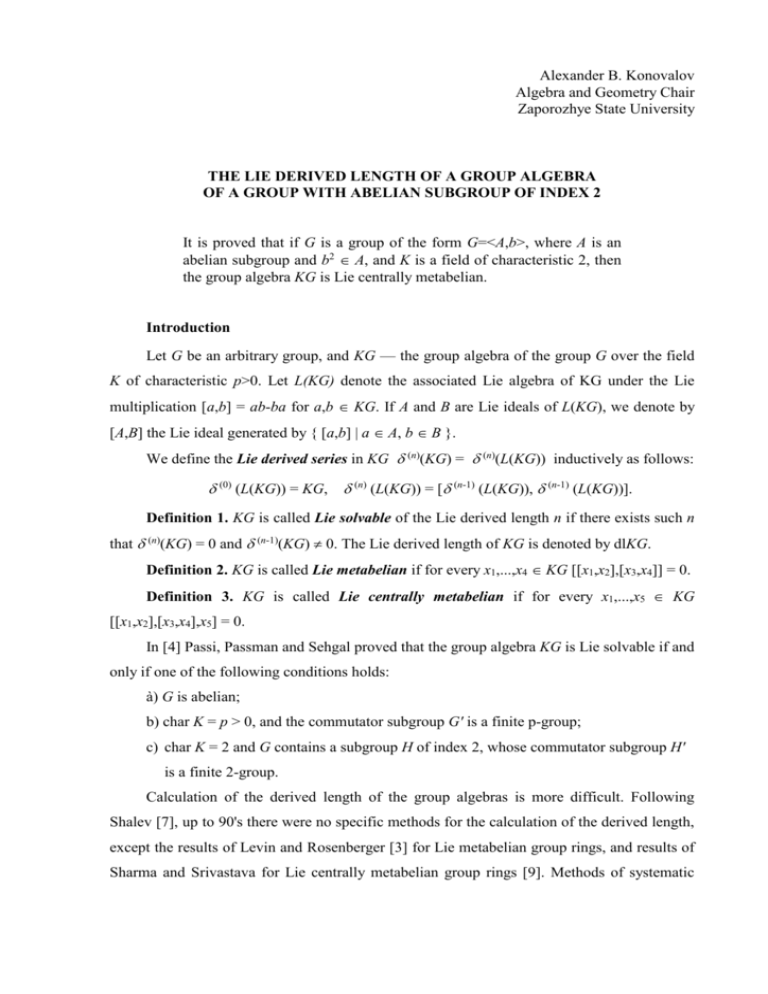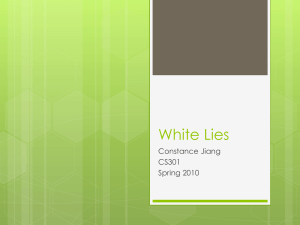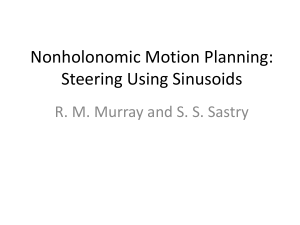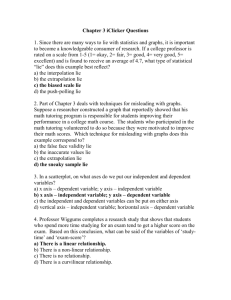doc - Dr. Alexander Konovalov
advertisement

Alexander B. Konovalov
Algebra and Geometry Chair
Zaporozhye State University
THE LIE DERIVED LENGTH OF A GROUP ALGEBRA
OF A GROUP WITH ABELIAN SUBGROUP OF INDEX 2
It is proved that if G is a group of the form G=<A,b>, where A is an
abelian subgroup and b2 A, and K is a field of characteristic 2, then
the group algebra KG is Lie centrally metabelian.
Introduction
Let G be an arbitrary group, and KG — the group algebra of the group G over the field
K of characteristic p>0. Let L(KG) denote the associated Lie algebra of KG under the Lie
multiplication [a,b] = ab-ba for a,b KG. If A and B are Lie ideals of L(KG), we denote by
[A,B] the Lie ideal generated by { [a,b] | a A, b B }.
We define the Lie derived series in KG (n)(KG) = (n)(L(KG)) inductively as follows:
(0) (L(KG)) = KG, (n) (L(KG)) = [ (n-1) (L(KG)), (n-1) (L(KG))].
Definition 1. KG is called Lie solvable of the Lie derived length n if there exists such n
that (n)(KG) = 0 and (n-1)(KG) 0. The Lie derived length of KG is denoted by dlKG.
Definition 2. KG is called Lie metabelian if for every x1,...,x4 KG [[x1,x2],[x3,x4]] = 0.
Definition 3. KG is called Lie centrally metabelian if for every x1,...,x5 KG
[[x1,x2],[x3,x4],x5] = 0.
In [4] Passi, Passman and Sehgal proved that the group algebra KG is Lie solvable if and
only if one of the following conditions holds:
à) G is abelian;
b) char K = p > 0, and the commutator subgroup G' is a finite p-group;
c) char K = 2 and G contains a subgroup H of index 2, whose commutator subgroup H'
is a finite 2-group.
Calculation of the derived length of the group algebras is more difficult. Following
Shalev [7], up to 90's there were no specific methods for the calculation of the derived length,
except the results of Levin and Rosenberger [3] for Lie metabelian group rings, and results of
Sharma and Srivastava for Lie centrally metabelian group rings [9]. Methods of systematic
calculation of the derived length were introduced by Shalev in [7,8], and they raised a range of
new questions.
In particular, Külshammer and Sharma, Sahai and Srivastava, Sharma and Srivastava
described Lie centrally metabelian group rings of characteristic p>2 [2,6,9].
Sahai [5]
obtained necessary and sufficient condition for a group algebra to have the Lie derived length
at most 3 for charK2. As was pointed out by A.Bovdi in [1], for p=2 these two problems are
still open. Note that the Lie derived length of Lie centrally metabelian rings is equal to 3, so
the solution of the first problem would be very useful for the second one.
Previously it was proved by the author [10] that the modular group algebras of 2-groups
of maximal class are Lie centrally metabelian. In this paper we deal with the mentioned
problems in more general case, namely, when G is a group of the form G=<A,b>, where A is
an abelian subgroup and b2 A.
The main result of this paper is that KG is Lie centrally metabelian group algebra. This
means that its Lie derived length is at most 3.
Several facts about the group algebra
Let K is a field of characteristic 2 and G = <A,b> , where A is an abelian subgroup and
b2 belongs to A. Note that by the theorem of Passi, Passman and Sehgal [4] if KG is Lie
solvable non-commutative group algebra over the field of characteristic 2, then either |G'|=2n
or G contains a subgroup H such that |H'|=2n, so KG is modular.
It is clear, that every element x of the group algebra KG could be uniquely written in the
form x = x1 + x2 b, where xi belongs to the commutative group algebra KA. The elements xi are
called components of the element x. It is obvious that two elements of KG x1+x2 b and y1+y2b
are equal if and only if xi = yi, i=1,2.
For a KA we denote by a an element b-1ab. Since A has index 2, A is normal in G, and
a KA. Thus we obtained an automorphism of order 2 of the group algebra KA. Note that
since b2 A, b 2 b 1b2 b b2 .
Now we extend this mapping onto the entire group algebra KG as follows: if
x = x1 + x 2 b then x = x1 + x 2 b . We also obtain an automorphism of order 2. Such mapping
x x we call a conjugation. Note that for x = x1 + x2 b we have
b 1 xb b 1 x1b b 1 x2 b x1 x2 b x , i.e. xb bx .
An element z KG such that z z is called symmetric. In the following lemma we
obtain useful characterisation of symmetric elements of KG.
Lemma 1. z KG commute with b KG z z .
Proof. Let z=z 1 +z 2 b. Then zb ( z1 z 2 b)b z 2 b 2 z1b . From the other side,
bz b( z1 z 2 b) bz1 bz 2 b z 2 b2 z1b . If zb=bz, then z 2 b2 z 2 b2 and z1b=z1b . Since b is a
unit, this is possible only when z1 z1 and z 2=z 2 . The inverse statement is obvious.
Taking into consideration that bx xb and b2 A, we obtain the following useful rule
of multiplication in KG.
Lemma 2. Let x,y KG, x x1 + x 2 b and y y1 y 2 b . Then
( x1 + x 2 b)( y1 y 2 b) ( x1 y1 x 2 y 2 b 2 ) ( x 2 y1 x1 y 2 )b .
Corollary 1. x x , y y xy = yx.
Proof.
xy ( x1 y1 x2 y2 b2 ) ( x2 y1 x1 y2 )b ,
yx ( y1 x1 y2 x2 b2 ) ( y2 x1 y1 x 2 )b
by lemma 2. Since x and y are symmetric and KA is commutative, right parts of this equalities
coincide.
As we can see from the Corollary 1, symmetric elements commute each with other. But
they may not commute with the entire KG. The next lemma gives us sufficient condition for
an element of KG to lie in its centre Z(KG), which will be useful for the further investigation
of the Lie structure of KG.
Lemma 3. Let z KA, and z z . Then z Z(KG).
Proof. Let
x x1+ x 2 b be an arbitrary element of KG, and z KA. Then
z ( x1+ x 2 b) zx1 zx 2 b x1 z x 2 bz ( x1+ x 2 b) z , as required.
Proof of the Theorem
Theorem. Let K be a field of characteristic 2, G = <A,b> , where A abelian and b2 A.
Then the group algebra KG is Lie centrally metabelian.
Proof. By the theorem of Passi, Passman and Sehgal [4], KG is Lie solvable. It is
sufficient to prove the Theorem to verify that (3)(KG) Z(KG), i.e. for every x1,...,x4 KG
the commutator of the form [[x1,x2],[x3,x4]] lies in the centre Z(KG).
Let x x1 + x 2 b and y y1 y 2 b . For the sake of convenience, we will write [x,y] =
xy+yx instead of [x,y] = xy-yx since this is the same in the case of charK=2. Thus we have
x
1
+ x 2 b, y1 y 2 b ( x1 + x 2 b)( y1 y 2 b) ( y1 y 2 b)( x1 + x 2 b)
( x1 y1 x 2 y 2 b 2 x1 y1 x 2 y 2 b 2 ) ( x 2 y1 x1 y 2 x 2 y1 x1 y 2 )b
( x2 y2 x2 y2 )b2 ( x1 x1 ) y2 ( x2 ( y1 y1 ) b .
Note that the first component of [x,y] is symmetric, while the second one is not
necessarily symmetric.
Let [x1,x2] = = 1 + 2b and [x3,x4] = = 1 + 2b lies in
(2)
(KG). Then their first
components 1 and 1 are symmetric. By the rule just obtained, the second component of
[,] vanishes, while the first is equal to ( 2 2 2 2 )b 2 . Thus [[x1,x2],[x3,x4]] is a symmetric
element of the group algebra KA. Now by lemma 3 [[x1,x2],[x3,x4]] lies in the centre of KG, as
required.
n
n
n
Remark. In the conditions of the Theorem, if A is abelian of the type ( 2 1 ,2 2 ,...,2 k ) ,
where n1 n2 ... nk , k 2, n1 2 , b2=1 and a A
b-1ab = a-1, then:
a) dlKG is exactly 3, if n1 > 2;
b) KG is Lie metabelian and dlKG = 2, if n1 = 2, and ni = 1 for i > 1.
Acknowledgement. The author wishes thank to Prof. A. A. Bovdi for drawing attention
to the problem on the 5th International Conference "Groups and Group Rings" held in
Białystok, Poland, September 16-20, 1997, and for opportunity to read the paper [1] before
publication.
References
1. Bovdi A.A. The group of units of a group algebra of characteristic p // Publ.Math.Debrecen.-1998.-52,№ 1-2.p.193-244.
2. Külshammer B., Sharma R.K. Lie centrally metabelian group rings in characteristic 3 // J.Algebra.-1996.-180.p.111-120.
3. Levin F., Rosenberger G. Lie metabelian group rings // Ruhr-Universität, Bochum.-1985.- Preprint No.60.
4. Passi I.B.S., Passman D.S, Sehgal S.K. Lie solvable group rings // Canad. J .Math.-1973.-25.- p.748-757.
5. Sahai M. Lie solvable group algebras of derived length three // Publ. Mat.- 1995.- 39, № 2.- p. 233- 240.
6. Sahai M., Srivastava J.B. A note on Lie centrally metabelian group algebras // J.Algebra.-1997.-187.-p.7-15.
7. Shalev A. The derived length of Lie soluble group rings I // J. Pure Appl. Algebra.- 1992.- 78.- p.291-300.
8. Shalev A. The derived length of Lie soluble group rings II // J.London Math. Soc.(2).-1994.-49,№1.-p.93-99.
9. Sharma R.K., Srivastava J.B. Lie centrally metabelian group rings // J. Algebra.- 1992.- 151.- p.476-486.
10.Konovalov A.B. Wreath products in the unit group of modular group algebras of 2-groups of maximal class //
Ph.D. thesis.- Mathematical Institute of the Ukrainian National Academy of Sciences, Kiev.- 1995.
Alexander B. Konovalov
P.O.Box 1317, Central Post Office
330000 Zaporozhye, Ukraine






